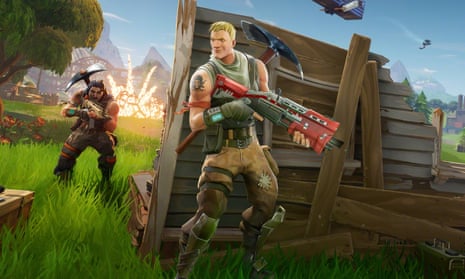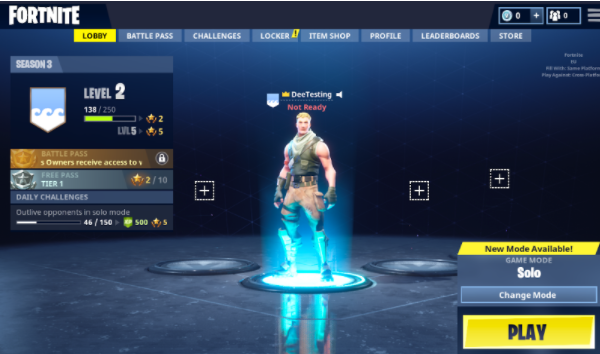Fortnite: a parents guide to the most popular video game in schools | Games | The Guardian

Fortnite: a parents' guide to the most popular video game in schools


Y ou know a video game has made it when ITV daytime programme This Morning posts on its Facebook page asking parents if their kids are addicted. You can be doubly sure when that post attracts almost 60,000 comments. In this case the game is Fortnite: Battle Royale, a bright, brash multiplayer shooter. Released in September 2017, it is now one of the biggest online games out there, attracting mounting concern from the mainstream media.
With more than 200m players worldwide, the chances are either your children or their friends are already passionate fans. For some, that fandom may well be bordering on obsession. Should you be worried? Here’s what you need to know about the game.
How to survive in Fortnite if you're old and slowWhat is Fortnite: Battle Royale?
In short, it’s a mass online brawl where 100 players leap out of a flying bus on to a small island and then fight each other until only one is left. Hidden around the island are weapons and items, including rifles, traps and grenade launchers, and players must arm themselves while exploring the landscape and buildings. It’s also possible to collect resources that allow you to build structures where you can hide or defend yourself. As the match progresses, the playable area of land is continually reduced, so participants are forced closer and closer together. The last survivor is the winner. Although it’s technically a shooter, you can actually win with very few kills just by using a careful, stealthy approach to play.
Where did it come from?
Fortnite was originally released in July 2017, but it actually started out as a four-player cooperative survival game set on a postapocalyptic Earth. Players had to build shelters and defend themselves against marauding zombies. Later in the year, however, the game’s developer, Epic, noticed the huge success of PC title PlayerUnknown’s Battlegrounds (PUBG), which pits 100 players against each other in a last-man-standing battle. PUBG was highly influenced by the Hunger Games novels and by the Japanese movie Battle Royale, and it’s sold over 30m copies worldwide. Duly inspired, Epic decided to release a new version of Fortnite featuring very similar gameplay. Hence, Fortnite: Battle Royale.
The developer made three brilliant decisions with this game mode. First it was launched as a standalone title separate from the original Fortnite (now known as Fortnite: Save the World), allowing it to gain a dedicated fanbase, secondly, it was released as a completely free digital download, which made it easily accessible, and thirdly it came out not just on PC, but on Xbox and PlayStation, and later on smartphone and Switch – which meant everyone who had heard about PlayerUnknown’s Battlegrounds but didn’t have a PC could now play something very similar, for free. (An Xbox One version of PlayerUnknown’s Battlegrounds is now available, but Fornite beat it to the punch.)
Why is it so popular with kids?
Well, it’s free, it’s fun and it has a very silly, offbeat sense of humour. While PUGB has a serious, realistic visual style, Fortnite: Battle Royale has very bright, almost cartoon-like graphics as well as loads of ridiculous items and costumes, such as space suits and dinosaur outfits.
You can also pull a variety of dance moves during the game, and some of these have taken on a cult appeal in schoolyards around the globe. The Floss, inspired by the viral video of the boy dancing with Katy Perry during her Saturday Night Live appearance last spring, is basically the new dab. All of this means the game is really fun to watch as well as play, so many of the streamers and YouTubers who play the game – such as Ninja, Tfue and Loeya – have become huge stars. . They’re broadcasting many hours of themselves playing the game to their millions of fans, making Fortnite the most watched game on major streaming service Twitch.
It’s also possible to team up with a friend, or group of friends, and compete as a duo or a squad. This adds a social element, and participants are able to chat as they play using headsets and microphones. Many children are now forming Fortnite teams, and spending a lot of their free time playing and practising the game together. There is a non-competitive mode called Playground where pals can meet and practise, or make up their own activities, and a Creative mode, which lets players build and share their own mini Fortnite islands.
Cleverly, the developer is adding new items, features and play modes on a weekly basis so there is always a new reason to come back and play, and fans like to show off that they have the latest gear.
What if my child has a different console than their friends?
Fortnite is a cross-platform game, which means you can play with friends no matter what machines they have. If you own an Xbox One, you can play in the same squad as someone with a PS4, Nintendo Switch, iPad, or an Android phone. To make it work however, everyone needs to have an Epic Games account, and they’ll need to be friends on the Epic Games system. The game’s online FAQ explains how to do this.
How much does it cost?
The game is free and players are able to unlock new items as they progress without paying anything. But if you purchase a Premium Battle Pass you gain access to exclusive clothing and items which are tiered so that doing well in the game or carrying out weekly challenges to earn more pointsunlocks access to more items. A Battle Pass costs 950 V-Bucks, which is the game’s own currency – you need to pay £7.99 to download 1,000 V-Bucks, which lasts until the end of the season. Fortnite: Battle Royale is divided into seasons, with season ten just starting. After that a new pass will need to be purchased.
It’s also possible to buy new tiers individually so you can play them immediately. Each tier costs 150 V-Bucks to unlock in this way, and there are 100 tiers. (It’s highly unlikely anyone would buy them all, but that’s £120 worth.) Certain outfits are also available to buy separately.
Children and video games: a parent's guideNone of the items that are earned through the Battle Pass or bought in the store make the player more powerful or provide a gameplay advantage, they’re purely cosmetic. However, there is a lot of kudos attached to getting the latest, rarest clothing items and children will want to keep playing to unlock those items. You remember when you were at school and just had to have the latest cool Nikes? It’s like that, but virtual.
How do I limit how much they play?
If they’re playing on an Xbox, PlayStation or Switch you can use the parental controls to limit the length of gaming sessions (or ban them from the game entirely if you’re feeling despotic). It’s a good idea to set definite play sessions of, say, an hour or 90 minutes using some kind of timer (a stopwatch, an egg timer, or maybe ask Alexa for a countdown). You may need to have a Mastermind-style “I’ve started so I’ll finish” rule though: Fortnite matches can last up to 20 minutes and if you demand they finish playing in the middle of a game, they’ll leave team-mates in the lurch and lose any points they’ve earned during that bout. That’s going to cause a lot of resentment.
Should parents be worried about the violence?
Although Fortnite is a multiplayer shooter, it has a very bright, friendly visual style and it does not depict bloody violence. Like the Nintendo game Splatoon, it takes lots of the enjoyable gameplay concepts from more mature shooting games but places them in a non-threatening, non-realistic world. My sons call it “Call of Duty for kids”.
Is Fortnite more addictive than other games?
The concept of video game addiction is highly contentious within the medical community and although the World Health Organisation has recently recognised gaming disorder as a condition, there are plenty of scientists, researchers and academics who disagree with the WHO’s decision.
Certainly, Fortnite contains no unique gameplay systems, or ‘compulsion loops’, that make it different to, or more ‘addictive’ than, other action video games. It’s more that the game combines many different elements – nice visuals, good shooting mechanics, an interesting building component, fun emotes, and lots of support and interest from YouTubers – into one package, which is free to download.
The good news is, as with any game, the obsession will eventually pass for all but the most committed players. Managing and moderating a child’s access to the game can be challenging, but setting limits using parental controls and incentivising other non-screen pastimes are good habits to get into. On the bright side, if your kids are really good at Fortnite, there’s a growing professional eSports scene around the game, complete with cash prizes. The recent Fortnite World Cup in New York, offered $30m in prize money to the 100 participants. Although this sort of success is very rare, you never know which childhood hobby might turn into a living.
- This story has been updated to reflect changes to the game, new platforms and current concerns about games addiction
- How to survive in Fortnite if you’re old and slow


